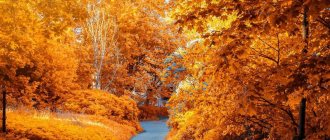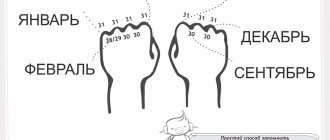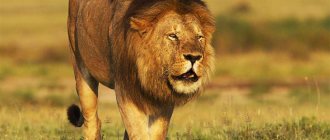Autumn signs of autumn in living and inanimate nature: list
For many schoolchildren, autumn is associated with the beginning of a new school year; at this time, children meet with their friends and classmates, and, dressed in school uniforms, go to gain new knowledge.
There are the following signs of the onset of autumn:
- Surely the kids noticed when autumn came, the sun had disappeared somewhere, and the sky was covered with clouds. Even in sunny weather, it is no longer so warm outside (you can tell by the way people start dressing). Light T-shirts and dresses are replaced by jackets and jeans, and with the onset of October-December, many people wear coats and jackets.
- Despite the fact that summer is hot, there are, of course, windy weather. But it’s more pleasing, because when a warm breeze blows, it’s refreshing. But strong gusts of wind in autumn are not so pleasant, because the cold wind blows with such force that it tears leaves from the trees.
- Autumn is characterized by frequent fogs, and mothers begin to monitor weather changes, because in autumn the weather often changes, and dressing correctly is very important at such a time, because... it's very easy to get sick. By the way, with climate change, many children begin to get colds, which is rarely seen in the summer.
- The coming autumn can be seen in the plants, for example, how grapes or currants turn red, chestnuts and many other trees and shrubs turn yellow. In September it is already possible to collect fallen maple leaves. They are often used to make appliques or various bouquets. But it is impossible to determine the onset of autumn by looking at coniferous trees, because such trees are green both in summer and winter.
Autumn motives
- You can determine weather changes by watching animals. For example, most birds hide from the cold by flying to warmer regions. Of course, there are those who are not afraid of the cold - these are pigeons, crows and sparrows. But heat-loving birds, sensing the onset of rainy autumn, immediately fly far to the south with their chicks.
- There are animals that hibernate, such as bears, raccoons, badgers, hedgehogs and many others, especially those that live in minks. The hare, fox and squirrels change their color, making it easier for them to camouflage themselves from predators. As you know, squirrels are very thrifty - so they prepare a lot of nuts and acorns for the winter, which they will feed on throughout the cold weather. And they collect food in the fall, when nuts and acorns are ripe. This can also be observed.
- Pesky flies, mosquitoes and many insects also hide with the onset of the slightest cold weather.
- Why has the day become shorter? This also characterizes autumn. If the sun sets earlier than usual, then you can expect the onset of cold days. This is a sign of autumn in inanimate nature.
- Getting closer to winter, you can see frost in the mornings. These are small particles of dew that have frozen on the leaves and surfaces in an uneven, prickly layer.
- There is even ice in the fall; this often happens at the end of November, when the air temperature reaches sub-zero values. By this time people are already wearing hats, gloves and scarves. The weather promises that winter is just around the corner.
Autumn is a very bright and beautiful time of year, the roads are covered with a golden “blanket”, you can watch beautiful landscapes and birds flying away to warmer climes. Even though the weather is rainy in autumn, it gives us the opportunity to observe the beauty of nature.
Autumn is also greeted by clothes
Over the summer, children get used to not being forced to wear a hat or jacket. Unless you have to dress warmer for a few days during cold weather. But they know that the time will come when they can run to the river in shorts again.
One day, the parents put on rubber boots, a hat and a jacket for the child. Signs of autumn can be seen even in outerwear. The child may not understand why he is being tortured so much. Not all children like to be warmly dressed, because they do not understand that it is cold outside and autumn has come.
It's time to tell your child about the signs of autumn. For children, so that they don’t get offended or sad, it’s enough to show them a lot of interesting things on the street while walking. It is clear that in September there are not many signs of autumn yet, many trees are still green, so it is best to talk about migratory birds, for example. It is advisable for an adult to remember his childhood; probably, as a child, he calmed down when he saw his friend also in a warm jacket and hat. It is important to give girls a bright umbrella.
Objects and phenomena of living and inanimate nature in autumn: description of observations
On the territory of our country one can often observe changes in the weather and nature, which “adjusts” to the coming changes. Many of the phenomena that we observe are associated specifically with the seasons and are therefore called seasonal. One of the most beautiful times of the year is autumn.
During this period, nature is painted with golden colors, all animals and plants are preparing for the cold winter and you can observe the most amazing changes and phenomena. Autumn is characterized by the following main changes:
- Fogs. This phenomenon can be explained by the fact that the earth heats up during the day, and at night the temperature is already below zero, so fog, dew and even frost are observed with sunrise
- Shower. Autumn is associated with rainy weather, and it is during this period that heavy rains are observed - in other words, downpour
- Wind. It is in the fall that when you go outside you can encounter strong gusts of wind, which are often accompanied by rain or even hail.
- It gets dark earlier
- Cloudy weather
- You can see thin ice on ponds and puddles, but standing on it, much less playing on it, is very dangerous; it’s better to wait until winter
- The onset of winter can also be characterized by “Indian” summer. During this period, a heavy milky fog falls to the ground, filling the air with dampness.
- At the end of autumn, rainy weather is diluted by light snowfall, after which there is often ice
Golden autumn
This is a characteristic of inanimate nature that can be observed in the fall, but changes in living nature include:
- Animals such as fox, squirrel and hare change their color
- Many animals hibernate in late autumn
- Birds fly to warmer climes
- Insects also hide from the cold weather, you can no longer see butterflies and ladybugs, you can’t hear the whistle of grasshoppers, bees don’t buzz and don’t pollinate plants, mosquitoes and flies are also becoming less and less common
- Leaf fall. This is the first sign that golden autumn is coming. The castings turn yellow, and with a strong gust of wind, trees and bushes are freed from them. All roads are covered with a beautiful golden carpet
Autumn is a wonderful time of year that prepares nature and people for the cold frosty winter. This time gives us a break from the hot and stuffy summer days. But the first ones who begin to respond to climate changes are plants. Berries and vegetables are fully ripening, and the trees are dressed in golden foliage.
deep autumn
Farewell to the Motherland
Flocks of birds fly away, beyond the blue sea. All the trees shine in a multi-colored dress. Konstantin Balmont
Each degree of temperature drop from +10 to +5, which lasts from the end of September to mid-October, is a criterion for the departure of a certain species of bird. Nature here has everything strictly regulated so as not to create a crowd in air traffic.
An important step in the period is when the average daily temperature reaches +8, when heating is turned on in houses.
Birds fly south. © Foto Factory | Shutterstock.com
Golden autumn ends on October 14 - on the holiday of Intercession. People have long noticed that the first snow falls on this day. In Moscow, such an event occurs infrequently, only once every 10 years. In deep autumn, which lasts almost until the end of the month, night frosts become a regular occurrence, and during the day the temperature rarely exceeds +10.
Winter signs of winter in living and inanimate nature: list
In anticipation of the New Year, many children know that the luxurious time of year has arrived - winter. Gifts, holidays and Father Frost and the Snow Maiden are not all indicators that winter has come. Of course, it comes a month earlier - December 1st. This is a fabulous time when you can play in the snow and sculpt a Snow Woman, we see stunning drawings on the windows, and there is beautiful snowy weather outside.
In anticipation of the onset of winter, we are all waiting for a fairy tale, wish fulfillment and magic. This is how we associate cold winter. But these are not all the indicators by which one can determine the onset of such a wonderful period:
- Firstly, everyone dresses warmly enough. A down jacket or fur coat is used as outerwear; people wear warm gloves and hats, and in very “severe” weather - huge scarves and thermal underwear. It is very important to dress as warmly as possible in such cold weather, because you can easily catch a cold and miss the entire winter holidays
- Snowfall is also the main characteristic of the winter period.
- The winter sky is quite heavy and seems to hang right above your head. There is moisture and frosty freshness in the air
- Ice. Walking or driving in winter is very dangerous; for convenience, many people wear snowshoes, and their cars are “changed” to winter tires. After all, it’s very easy to slip, and worse, to injure your leg or arm.
winter snowstorm
- If a strong wind blows and snow falls, it becomes a blizzard. It’s very exciting to watch such weather from the window, but if you get caught in a strong wind with snow, it’s quite unpleasant
- As children, we all really loved icicles. And this is another sign of winter. In other words, an icicle is a cone-shaped piece of ice that can most often be found on roofs or trees.
- Animals, birds and insects, unfortunately, can be found very rarely, because birds fly away to warmer climes, animals hibernate, and insects hide from the severe frosts that are typical for winter
- Days are much shorter than nights
Despite the cold temperatures and snowstorms, winter is a wonderful time; many games can only be played thanks to the snow that only falls in winter. Skiing, sledding, snowboarding, playing snowballs or sculpting various figures out of snow - these are very exciting and educational activities that are possible only in winter. Therefore, the winter holidays should not be spent sitting in front of a computer monitor, but rather have a great free time with friends or family.
Pre-winter
Deserted Forest
Late fall. The rooks flew away, the forest was exposed, the fields were empty. Nikolay Nekrasov
A golden leaf is already covering the wet ground in the forest... I boldly trample with my foot the beauty of the spring forest. Apollo Maykov
A sign of this time is leaf fall. When the temperature passes through 0, the moisture contained in the cutting freezes and it breaks off. The leaf makes a quiet farewell flight...
Empty forest. © S.Borisov | Shutterstock.com
It's a busy time for motorists to change their tires. Summer tires at temperatures below +5 lose their properties and do not provide proper grip. As snow events become more frequent, deep autumn resigns its powers.
snow powder
Fog lay over the fields, a caravan of noisy geese stretched to the south: a rather boring time was approaching; It was already November outside the yard. Alexander Pushkin
The average date for the formation of temporary snow cover is October 28, and it also opens the gates to the pre-winter. The weather becomes chilly and windy. Snow falls, lies a little, but still melts. The streets are getting slushy.
First snow. © Lutsan Pavlo | Shutterstock.com
Objects and phenomena of living and inanimate nature in winter: description of observations
Nature is everything that surrounds us and is created by human hands. Conditionally, nature can be divided into living and nonliving. The first group includes plants, animals, fungi, humans, and microbes. But to inanimate nature: the sun, air, stars, soil, precipitation, etc.
In winter, summer, autumn and spring, all phenomena change smoothly, and this is how we can determine the seasons of the year. Winter is the coldest time of the year, but this is also the most beautiful time. In winter, the season of fun snowball fights opens, children ride on slides and sleds, make a snow woman, and most importantly, everyone is looking forward to a fabulous New Year. This time can be determined by the following signs:
- Snow is more often observed in the form of precipitation. Snowflakes fall to the ground either independently or in flakes. And also only in winter you can see snowfall - this is heavy snowfall
- Blizzard and blizzard
- Ice. Of course, all kids love to skate, but this activity is quite dangerous, so you can only play on the ice if accompanied by adults
- Icicles can be found on the roofs of houses and tree branches. Therefore, you need to be careful, and it is better not to walk under houses, because if the temperature gets higher, the icicle can easily melt and fall
- Santa Claus decorates the windows with beautiful patterns
- All rivers and lakes are covered with a thick layer of ice, which is called freeze-up
Animals in winter
The following changes can be found in living nature:
- Many animals change their color, such as the hare, squirrel and fox
- Bears and hedgehogs hibernate
- Bullfinches and tits arrive and replace the bulk of the birds
- People dress in warm clothes
When the snow begins to melt and the patterns on the windows disappear, the sun begins to warm up, and the days become longer - then winter begins to gradually transition into another season - spring. What other signs of the spring season there are are described in the next paragraph.
First winter
First snowstorms
The dug-up road sleeps. Today she dreamed that there was just a little time left to wait for the gray winter... Sergei Yesenin
Climatic autumn usually ends on November 10, when the average daily temperature steadily passes through 0. The first winter is the time of the first snowfalls and the first daytime “minuses”. Snow cover is becoming more and more stable and the long-term average falls on November 28th. However, in recent history there have been cases when it remained lying until spring from October 31st, and sometimes appeared only after the New Year.
Spring signs of spring in living and inanimate nature: list
Spring is associated with new life, because during this period the earth wakes up from winter hibernation, nature begins to bloom, the first still green petals and bunches appear. This is the most wonderful time, the sun is brighter and the sky is clear, and there is freshness in the air.
It is very easy to understand exactly when spring begins; there are a large number of phenomena and processes that characterize such a season, for example:
- The first green flowers appear
- Animals wake up from hibernation
- Bunnies, squirrels and foxes again change the color of their coats, so they camouflage themselves with their environment. Many animals begin to shed
- Buds appear, and from them - flowers
- You can hear the singing of birds returning from warmer climes
- Spring is the time for the birth of a new generation in animals
- Birds begin to build nests
In spring everything comes to life
From inanimate nature:
- The first is the melting of snow
- Streams begin to gurgle
- In winter there are practically no thunderstorms, but in spring you can encounter such a phenomenon
- Ice drift - this phenomenon occurs because the ice begins to melt and smoothly moves along the rivers
If you watch what people do, you can also see changes. Spring is considered the time of cleaning, because after winter it is worth cleaning your home. Also, preparations are underway to plant a vegetable garden, especially if a person lives in a rural area.
And the day got shorter
The children will certainly notice that it is getting dark earlier. If in August it became dark already at 9 o’clock in the evening, then in September even earlier. It's getting late. It is easier to explain to children that in the morning and evening the day decreases by 2 minutes. If in June at 22.00 the sun was just setting, then in mid-December it was already dark at 16.00. Why is this happening? If you have an encyclopedia and a globe at hand, then you need to show how the Earth rotates around the Sun throughout the year. They will probably be surprised when they learn about spring in Australia at the moment. Late dawn and early sunset are signs of autumn in inanimate nature, along with constant rains and winds.
Objects and phenomena of living and inanimate nature in spring: description of observations
After a cold winter, everyone is looking forward to warmer days. Literally from the very first days of spring, the sun's rays begin to warm up, and at the same time flowers appear, the grass turns green, the trees bloom, and the birds begin to sing. In other words, the Earth comes to life again and wakes up.
- The first sign is the snow is melting. The icicles are melting and the beautiful patterns on the windows are gradually disappearing.
- The day is getting longer.
- If in winter there are often leaden clouds, and the sky is gray and dull, then in spring the sky becomes lighter, the clouds disperse and the sky becomes clean and clear.
- Plants also react to the arrival of spring and demonstrate this by the appearance of green leaves, buds, spruce and alder blooming young cones. Flowers gradually bloom, bees and other insects appear.
Nature comes alive in spring
- Spring is also associated with the fluffy “seals” of the willow tree; they are carried to church on Palm Sunday. Also, one of the most important spring holidays is March 8th. This is International Women's Day, and flowers such as tulips are considered a symbol.
- The birds are flying home again, and this can be heard from the beautiful singing. Swallows begin to build nests and have offspring.
- Animals change their warm clothes to lighter ones. At the same time, the color of the coat itself.
- People also change their wardrobe, hiding fur coats, warm hats and boots until next winter.
Vienna also has more exciting activities, for example, closer to the May holidays, many go fishing, pick mushrooms, start grilling kebabs and relax a lot in nature, enjoying the beautiful nature.
Summer signs of summer in living and inanimate nature: list
Of course, all children know when summer begins, because... After a hard school year, the long-awaited summer holidays are coming. That is why summer is the most favorite time of the year. Many go to visit their grandmothers or to a resort with their parents. The sea, the beach and a lot of fun await every child. But this is not the only indicator that summer has come; there are also such changes in living and inanimate nature, for example:
- Weather. The wind is dry, the temperature is high, so even the nights in summer are quite warm. But if the day is very hot and the sky is clear as a tear, at one moment it can start raining with a thunderstorm, after which you can often see a rainbow
- In the morning you can find dew on the leaves and grass
- Winds can be strong with variable gusts and frequent changes of direction
Signs of summer
Hot days of summer are diluted by rainy weather, and summer rain is divided into several types:
- Ordinary
- Short term. It is also called blind or mushroom, accompanied by sunny weather
- Shower. It starts suddenly. A large amount of water falls out in a very short time. Accompanied by wind and thunder
- City-shaped. Along with the water droplets, hail particles also fall out. They flow powerfully and quickly, which consequently negatively affects agriculture
- The grass is bright green
- In summer, berries and fruits ripen, flowers bloom
- Already at the beginning of summer you can collect mushrooms after the rain
In summer, people dress quite lightly, wear sunglasses and hats to protect them from the hot rays of the sun. In agriculture, summer is a very important period; agronomists and landowners are cultivating the soil, looking after their gardens, picking berries and preserving them for the winter.
Objects and phenomena of living and inanimate nature in summer: description of observations
Using the textbook “The World Around us,” children starting from the second grade can become familiar with various anomalies and changes in the environment. All these changes change smoothly along with the seasons of the year, which is why they are often called seasonal.
The main objects and phenomena that can be encountered in the summer are:
- Hot weather
- Strong gusts of warm wind
- Rains, after which you can collect mushrooms
- Thunder is a sound phenomenon that is often accompanied by lightning
- hail
- After the rain a rainbow appears
- In the morning you can observe such a phenomenon as dew.
- The plants are dressed in green petals, there is a scent of flowers, and the fruits are ripening
- You can hear birds singing, bees buzzing and crickets ringing
- The day is longer than the night and you can watch the beautiful stars through the clear and clear sky.
Beautiful nature
Each season of the year is unique and beautiful in its own way:
- In autumn, all nature, plants, animals and people prepare for the cold. Trees turn yellow and shed their leaves, animals make provisions for the winter, change color, and some are preparing for hibernation. Birds fly to warmer climes, and insects hide. People take out warm clothes and umbrellas, collect ripe fruits and wait for frost.
- Winter is the time for snow-white fairy tales and fun games in the snow. The entire surface of the earth is covered with a thick layer of snow and ice. With the beginning of winter, children and adults are looking forward to the New Year holidays.
- In spring, the earth wakes up from its winter sleep, everything around blossoms, and a fresh aroma soars in the air. Birds return, animals also change their coats and crawl out of their burrows and continue their offspring. You can already find insects, birds and midges. And people are slowly planting vegetable gardens and orchards and preparing for the hot summer.
- Summer is my favorite time of year, because... The long-awaited vacation begins. Finally, you can enjoy warm days, soak up the sun and swim in the sea. Already at the beginning of summer you can savor delicious berries and fruits. In the summer you can pick mushrooms, go to the forest to pick flowers and relax in the fresh air.
Why is autumn like this and when will winter come?
The change of season occurs so that nature is renewed. The grass cannot remain green forever, the trees do not bloom or bear fruit all their lives. People and many animals that do not hibernate are characterized not only by wakefulness, but also by rest. Plants also need to rest. But the process of preparing for hibernation occurs slowly. How does the cycle happen in a year? The tree puts on leaves in the spring and bears fruits and berries in the summer. In autumn the leaves fall and the plant appears to die.
Any signs of autumn are a signal for wildlife to prepare to rest for more than three months. Why does it rain? Nature arranges everything intelligently. Precipitation is first needed to saturate the plants with moisture, then cold weather comes. Snow helps the trees and grass stay warm. If there is no snow, the plants may die in severe frosts.









